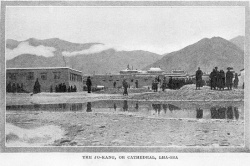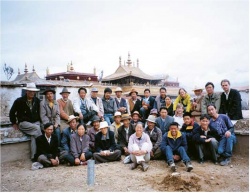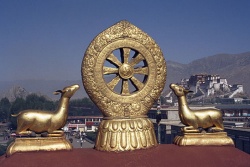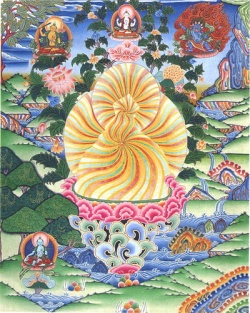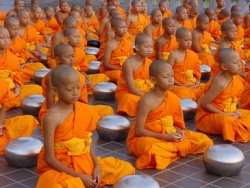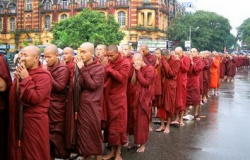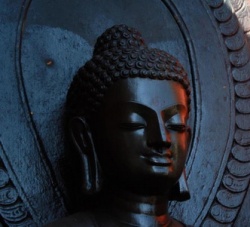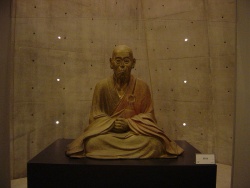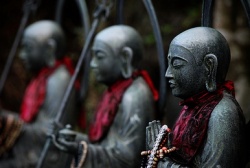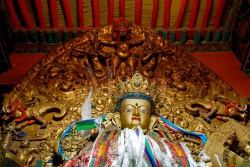10 Paramitas
The Ten Paramitas
1. Generosity (jinpa – sByin pa – Dana paramita)
2. Discipline energy / morality (tsultrim – tshul khrims – shila paramita)
3. Patience (zopa – bZod pa – Kshanti paramita)
4. Diligence (tsöndrü – brTson ’grus – Viry paramita)
5. Openness transcendental knowledge or insight (samten – bSam gTan – Dhyana paramita)
6. Knowledge (shérab – shes rab – Prajna paramita)
7. Method – skilful means (thab – thabs – upaya paramita)
8. Aspiration Power (mönlam – sMon lam – pranidhana paramita)
9. Strength (tob – sTobs – bala paramita)
10. Primordial Wisdom (yeshé – ye she – jnana paramita) Generosity
The Paramitas—ultimately—are actions which are free from the crimp of duality – actions which arise spontaneously from the non-dual state. They are the actions of the Bodhisattva—the awakened-mind warrior—who has gone beyond the confines of referentiality, and who dwells within the meaning of ocean and its ornamental waves. In Tibetan the word which equates to
‘Bodhisattva’ is ‘changchub sempa’ (byang chub sems dPa). Changchub sempa has a specific meaning which differs from the Sanskrit word, which means ‘one who has Bodhi’ or ‘one who has awakened-mind’ or ‘one who has the compassionate Mind
of Enlightenment’. The Tibetan spelling should be ‘byang chub sems pa’ – but we find instead that it is ‘byang chub sems dPa’. ‘dPa’ is a contraction of the word ‘dPa bo’ which means ‘warrior’ rather than ‘pa’ which means ‘person’. Changchub sempa therefore means awakened-mind warrior.
The first of these examples of appropriate spontaneity is generosity (jinpa – sByin pa – Dana paramita).
The awakened-mind warriors delight in unbounded wealth because their appreciation is unlimited. Appreciation generates generosity which knows no limits. It is unobstructed by the self-referencing territorialism which generates manipulative
pusillanimity. Awakened-mind warriors need no territory. Their Refuge is the security of insecurity. Their Refuge is the territory of intrinsic space, which is self-validating without the requirement of reference points. Objects, circumstances, and people—as subjects of appreciation—are not required to be fixed or frozen by awakened-mind warriors. Objects,
circumstances, and people are not employed for self-validation – and are therefore free to move. It is their natural reflex to move in the direction where they facilitate the greatest pleasure and satisfaction.
The Vajrayana view of wealth is grounded in the understanding that one owns everything that enters one’s sense fields. We own whatever we appreciate, to the extent that we appreciate it and for the duration that we appreciate it. We do not require personal ownership in order to own. Our ownership does not restrict the ownership of others, because our ownership is simply that of appreciative faculties.
This non-possessive, non-controlling absence of tenure is called ‘vajra greed’ or ‘non-dual greed’ – greed on behalf of others. Greed on behalf of all beings is both the maximum possible avarice, and the ultimate expansion of generosity.
Vajra greed is non-dual acquisitiveness – everything goes where it needs to go, with respect to where and by whom it will be most appreciated.
If my interest is in appreciation, then if you want something more than me—in terms of your capacity to appreciate it—then that is where it should naturally go. To focus on someone else’s greater appreciation is a far more profound experience of avarice for me than if I sought sole possession. Generosity—in this view—is that sense of connection, the sense of energy in relation to other people and their infinitely varied circumstances.
For those practitioners who have capacity, generosity is the non-referential acknowledgement of a superior position – a self-existent position of profound responsibility.
It is an interesting perceptual phenomenon, that adults are regarded as equal – regardless of their capacity, and regardless of their level of interpersonal responsibility. People are patently not equal with regard to many variables. When we say ‘people are not equal’, we are not saying ‘people are not intrinsically equal’. People
are all equal as beginninglessly enlightened beings – but in terms of their capacities, they are unequal. In terms of generosity, those with greater capacity—in whatever area—should naturally wish to help those who lack capacity.
We often assume that because someone is an adult, that they have our level of responsibility. If they do not, then we judge them according to that criterion as being deliberately culpable of lack of responsibility. Compassion as generosity is not feasible with such a view. If everyone is equally responsible for their acts, then we are impelled to judge them accordingly. We assume that they know what they are doing on the basis that we would appear to know what we are doing.
This view has nothing to do with shoring up self-esteem – but everything to do with bearing responsibility. As an awakened-mind warrior, one takes responsibility for being ‘the one who has to forgive’. As an awakened-mind
warrior, one takes responsibility for being ‘the one who makes the first move towards better relationships.’ As an awakened-mind warrior, one takes responsibility for being ‘the one who does not become angry in the face of those who are locked in neurotic patterns’.
A mother forgives the child who drops his dinner on the floor. She acknowledges her child’s incapacities. Her generosity provides instantaneous forgiveness. Her generosity provides opportunities for her child to acquire greater motor skills.
In this way the awakened-mind warrior develops infinite generous capacity to act for the benefit of everyone and everything, everywhere. Discipline
Discipline (tshul khrims / shila paramita / ethics or morality), according to Dzogchen, can also be spoken of as energy – naturally arising energy or spontaneous energy. Non-duality incites the flow of spontaneous compassionate activity in precise relation to circumstances. Each situation—with all its complicated facets—guides the activity of pure appropriateness.
Pure discipline—in the Tantric sense—is the ecstatic embrace of the Lama’s vision of ourselves. Pure discipline is based on our devotion to the Lama, rather than the self-determined and wilful adoption of a rigid code of conduct.
The process of referentiality saps the energy of naturally present compassionate activity. This is why discipline needs to be applied – in terms of adhering to a pattern of guidance given by the Lama. This is then a skilfully evoked pattern which approximates to compassionate activity for the disciple concerned.
The purpose of discipline is to overcome the compulsive nature of our habit patterns. For this to succeed we need to become transparent to ourselves. As practitioners we need to dwell in a limpid pool of self-awareness.
Discipline is necessary because of our primary ambivalence concerning practice and its result – realisation. Our primary ambivalence is that we wish for realisation at the same time as wishing against it.
Acknowledging this fact needs to underpin our lives as practitioners. There can be no progress unless we spend considerable time watching the play of this fact unfolding: day-by-day, week-by-week, and year-by-year. There are endless opportunities to watch.
We might love to think of ourselves as ceaselessly working for the benefit of everyone and everything, everywhere – but there are other things for which we might work more assiduously, such as our need to referentially establish ourselves in terms of solidity, comfort, distinction, continuity, and definition. These needs pervade our lives and pervert the
sparkling through of our beginninglessly enlightened nature. We are extremely dishonest about realisation. We want it but not now: we need a few more minutes in bed; we need to vent our spleen; we need to retreat into the form of boredom at tonight’s dinner plan – all rather than sit in the discomfort of non-conceptuality.
What we really want is to get as close as possible to realisation… and then sit back and admire our accomplishment.
Watching this push and pull – toward and away from the rules which we have applied to ourselves, is a primary practice of living the view. It induces an energetic sensation with which we must sit until it dissolves – this, is the acute claustrophobia of being a practitioner. It is a magnification of what occurs in formal practice, because it is applied in our everyday lives and is therefore
endless. When it reaches uncomfortable intensity, hilarity and relaxation are often the only way to encourage the sense of spaciousness. To cling to that intensity is merely to add another layer of referentiality.
Discipline is like a band-aid for the injury of duality. However, band-aids have their limitations. They lose adhesion and fall off as we lapse in our application. ‘Spiritual’ band-aids become dirty when we judge others according to the discipline we have adopted.
They become dirty because our discipline exists in order to temper our personal styles of playing with the primary ambivalence of wanting and not wanting realisation. ‘Band-aid discipline’ is no substitute for the real skin of realisation, but it has to suffice until such time as we can change.
We are immensely attracted to manipulating our lives in terms of discipline as another excuse to play with form in order to avoid emptiness. ‘Spiritualised earth element neurotics’ love nothing more than to impose strict sets of rules on themselves (and others) until they become crippled by such self-imposed bondage. When this crippling point is reached, we binge on whatever it is we were attempting to avoid.
This is the game where we divide ourselves into two people: the good and the bad – both of which are ugly, and far more entertaining than our tedious selves. This is the trap of ‘discipline as reference point’. Without the guidance of the Lama, we will need to watch ourselves falling into this trap – possibly over and over again, before it wears itself out.
Ngak’chang Rinpoche was once travelling by car to a retreat with our disciple Naljorma Jig’mèd. They became embroiled in a lengthy traffic jam and she commented, I’ve never known anyone with such patience. To which Ngak’chang Rinpoche replied, "Why do you say that? I think of myself as extremely impatient." Naljorma Jig’mèd responded, "But you don’t seem to be in any anxiety about being late."
Rinpoche laughed at that point and pointed out, "Well, I’m not impatient when there is nothing I can do to change a situation. If I thought we could get out of this jam by cutting across a field, then maybe you might witness impatience on my part."
Vajra-impatience is a paramita of the buddhakarma of destruction – but dualistic impatience is desperation – a frenetic kicking against limitations imposed by situations in which we feel insecure, fearful, out of touch, anxious, or lost.
Impatience is a means of seeking to control the momentum and direction at which circumstances unfold. The extent of impatience is commensurate with the degree to which reality refuses to cooperate with our dualistic derangement.
Patience—on the other hand—does not mean abdicating responsibility for attempting to move a circumstance or a person in a compassionately preferable direction. From the view of Vajrayana, patience or (Zopa (bZod pa – Kshanti paramita) does not mean acceptance, forbearance, and Suffering. According to Vajrayana, patience involves
intelligent open-minded striving, in which the situation is propelled at its optimal velocity – neither forcing it, nor failing in the attempt to facilitate movement. Both apathy and coercion are the result of referentiality with regard to the pace at which visible success is apparent. Patience looks different according to circumstances.
Patience does not mean that Lamas would not push a person to achieve – if they knew that failure to encourage, coax, or cajole would mean stagnation in the student.
Any form of teaching or learning exposes our degree of intelligent open-minded endeavour with regard to that for which we strive. This process becomes visible if we take the example of teaching a child to play a musical instrument. To force the
pace of the child’s learning can often result in a spectacular backfire, in which those involved in the situation lose all impetus to continue. If, however, we were not to encourage practice, the child would never develop the degree of self-discipline required to practise daily, and to achieve the results which provide continued motivation.
The practice of shi-nè involves the renunciation of attachment to form as a reference point. Through shi-nè we learn that we cannot force thought. We need to be completely purposelessly welcoming. Whatever thought arises simply moves in its own way. Any approach involving force results either in hilarity or frustration. One needs a sense of humour about one’s condition. One catches oneself trying to force meditation – repeatedly. All we can do, however, is watch ourselves in the process of
trying, until trying wears itself out with trying in the open space of awareness. This is patience in terms of shi-nè – as we speak of it from the point of view of the Four Naljors of Dzogchen sem-dé.
Patience is required in terms of learning anything: shi-nè, horse riding, thangka painting, or marksmanship with a .500 Linebaugh. If you have found the right Lama, patience requires the implementation of their instructions. The Lama’s instructions need to be followed exactly, rather than according to our own ideas – either in terms of our supposed meagre limitations, or in terms of our inflated sense of ourselves as perfectly qualified.
The only factor which alters the nature of our pace – is practice. Genuine practice is imbued with intelligent open-minded striving. The Lama provides the fount of knowledge from which we can glean the practices in which we could most effectively engage.
Practice is energetic; so if we disengage from the lugubrious slough of apathy and concomitantly open-mindedly persevere, the vectoral velocity of our energy becomes suffused with the brilliant nature of our non-dual unfolding.
Diligence
Diligence—tsöndrü (brTson ’grus – Virya paramita) was described by Chögyam Trungpa Rinpoche as energy. It could also be described as the quality of delight, of cheerful commitment or of joyful involvement.
Diligence is present when we relinquish resistance or when we refrain from obstructing situations. Outside the sphere of diligence there is always something we hold in reserve in order to maintain a solid, permanent, separate, continuous and defined project which is insulated from the intentionality of the Lama. We want to work with the Lama, but somehow we find ourselves incapable of the utter trust required to dispense with ancillary self-protective strategies and self-defensive manœuvres.
Diligence is the free energy we make available to the Lama and to ourselves in terms of carrying out the advice of the Lama. This is the energy which allows us to respond to circumstances appropriately.
This lack of resistance means that a quality of our energy manifests brilliantly in our activity. Vectoral movement towards the goal becomes an effortless effort – we plough through the waves of circumstances like a ship with ‘three sheets to the wind’. Without the free energy of tsöndrü we have yet to weigh anchor and leave the anal retentive harbour of rationalisation.
Confidence in the Lama allows tsöndrü to manifest as fearlessness with regard to the open sea. With tsöndrü we can face waves that swell higher than the t’gallants, and therefore situations move towards successful conclusions with self-governed impulsion. We do not have to stand outside the situation keeping a running commentary on our relative position, and therefore no time is wasted.
The energy of tsöndrü ensures that we do not miss the swell of opportunities as they arise in the ocean of our life circumstances. Tsöndrü is the joyous energy of complete involvement, rather than the timid parsimonious feeling of obligation. Joyful involvement is beyond self-referencing – and therefore we fail to seek Refuge in tiredness or boredom in respect of situations which are beyond our conceptual control.
Boredom with practice circumstances arises when the Lama’s advice fails to give us a greater sense of solidity, permanence, distinction, continuity and definition.
When we find it difficult to change from one activity to another at the Lama’s suggestion, there is usually some self-cherishing notion of ‘having a better idea’ with respect to ‘me and the ongoing me project’. I could breed surreptitious ploys in order to convince the Lama that perhaps I should be engaged in another more valuable task than the one he or she has devised.
Without tsöndrü it takes time to settle into what we are engaged upon at the behest of the Lama, and to feel that something is moving – but with tsöndrü we move immediately and are immediately fulfilled.
Tsöndrü is the sense of joyful involvement which is continuously present. It is not a question of merely getting into things or settling down to something – tsöndrü is the self-arising energy which becomes available through devotion. With devotion, tsöndrü is effortlessly instantaneous. Samten
Samten (bSam gTan – Dhyana paramita – meditative stability, concentration) is defined as Tsé gÇig Nyon-mong ’méd (rTse gCig nyon mongs med) meditative stability or stable attention bereft of conflictive emotions – the absence of referentiality.
Where referentiality is abandoned, conflictive emotions—such as territorialism, aggression, addiction, paranoia, and depression—spontaneously manifest as generosity, clarity, compassionate activity, self-accomplished activity, and pervasive intelligence.
The disconcerting human situations which arise for us all, fail to disquiet a person who has experience of samten. This is due to the fact that a person with experience of samten is not unavoidably impelled to act in a self-referencing manner. Experience of samten provides the stability to act appropriately and to be steadfast, rather than Suffering the government of habitual patterns and their concomitant manipulative self-serving strategies.
In the everyday world, a practitioner with experience of samten prioritises practice over their compulsive patterning. This does not mean that the person is not afflicted by conflictive emotions – but simply is not ridden by them. This allows such a person to make emotionally fraught decisions without the pain to self and others which is caused by vacillation and
tortuous indecision. Lacking experience of samten, one lacks the ability to live the view with integrity – particularly under duress. One becomes a fair weather practitioner – one who lacks consonance with Dharma, when Dharma would be most valuable. Lacking the ability to be consonant with Dharma under duress forces the bit firmly into one’s mouth and places the reins in the
hands of the dementedly despotic monkey of the conflictive emotions. The monkey has the whip and spurs which we have provided through our lack of experience of samten – and we are ridden with a brutality commensurate with the intensity of our neurotic neediness.
A practitioner with experience of samten has the capacity to be courageously honourable and forthright. This is evidenced by their ability to keep their word, to live a reliable existence, and to evolve a cheerful disposition in the face of difficulty. A practitioner lacking experience of samten thus exhibits moodiness, temperamental disposition, addictive tendencies, and interpersonally inexplicable behaviour.
A practitioner with experience of samten is a rider rather than one who is ridden. A reflection of samten is to be found in the rider’s ability to maintain their seat through difficult circumstances. Whatever the circumstantial movement: bucking, shying, bolting, jumping, rearing, working trot, or collected canter – the rider of samten has a body of experience which absorbs
the movement without disturbance to the security of his or her seat. The rider displays a co-operative movement in relation to the movement of circumstances – and the nature of that cooperation is Dharma.
To develop meditative stability requires an actual reliance both on the view and on the advice of the Lama. Meditative stability is only achieved through effort. It requires many hours in the saddle of the view. It requires many hours in the arena of meditative practice. It requires riding the trail of real vajra relationship with the Lama – rather than malingering in the slough of slovenly armchair equestrianism.
Life as a practitioner who rides rather than being ridden, can be excruciatingly uncomfortable. Some practitioners fall off and decide it is preferable to be ridden – in order to be closer to the warmth of the sand and the dung of the riding arena floor. To be a rider is to undermine reference points, and to ride cannot fail to elicit the fact of the level of our competence: insubstantiality, fear, isolation, vulnerability, and self-protective ignorance.
It is in our worst moments that we need to rely on our hours in the saddle of samten, in order to manifest the reality of the view and our relationship with the Lama.
At moments of difficulty, those without experience of samten adopt a fœtal position in the saddle – abdicating responsibility and expecting the Lama to rescue them. They cherish hopes that the Lama will co-operate with their neuroses, rather than overriding their dualistic rationale. Others will try to hide at the back of the riding arena, rather than face the challenge of abandoning their cherished yet useless methods of indulgence in repeated failure. The authentic practitioner, however, will ensure that their experience of samten is sufficient to proceed with courage and stability in devotion.
Shérab (shes rab – prajnaparamita) means intelligence or insight. Chögyam Trungpa Rinpoche called it: ‘… the all – seeing eye, the opposite of the ego’s watching itself doing everything.’
Shérab is complete insight into the referential patterns of the participants playing in every situation. The highest intelligence is to know the process of referentiality for what it is.
Practitioners develop shérab as they develop their practice. This process emerges through immersion in the relationship with the Lama, and the Lama’s teaching. Under these conditions of commitment and devotion – there is no choice regarding the development of shérab – flashes of insight simply begin to occur. You find out and understand who you are. You discover the stylistics of the
patterns by which your perception is conditioned. You discover the texture and fabric of your concept consciousness, your projections, and your relationship with your world.
This only occurs when we apply the teachings to ourselves and when we agree to accept a degree of discomfort, horror, hilarity, regret – and a great many other tones in the mind.
Shérab manifests at the point at which experiences of nyi’mèd percolate through the structure of the Tantric ngöndro (sNgon ’gro). This is the point at which the preliminaries are no longer preliminaries and one begins to see that one could practise in this way for the rest of one’s life.
Shérab exists in two forms. There is the shérab of knowing and the shérab of seeing. The shérab of knowing deals with the emotions – it cuts through self-referencing and its resultant emotions. The shérab of seeing is the transcendence of primitive preconceptions of the world, seeing situations as they actually are without our own projections. It allows for the possibility of pure appropriateness when dealing with situations.
Shérab is regarded as the two-edged sword that cuts the bondage of the confusion of self-referencing. The sword is two-edged – because it can cut in any direction – which is the manner of spontaneous appropriate activity.
To develop shérab is to become a vajra politician – aware of surrounding circumstances, yet aware of creating our version of those circumstances.
Vajra politicians do not submit to their perception of what is happening – they are slightly suspicious of their versions of reality and yet know that their versions are nonetheless connected with reality. Shérab enables vajra politicians to see around conditioned perceptual corners.
Shérab is immediate non-conceptual insight, yet—at the same time—it provides the basic inspiration for intelligent study. There is a natural desire to clarify and articulate the teachings and a curiosity to read and hear of how others have expressed
their insight into mind and the nature of Mind. At the same time it is necessary to maintain continuing discipline of meditational training. In this way concepts are never ‘merely concepts’ – and one’s approach remains fresh and alive.
Shérab, or discriminating awareness, is the state of clarity in which one is able to distinguish different states of mind; we are no longer excited or depressed by particular states of mind. States of mind are the ornaments of one’s awareness. Shérab—or intellect—is intuitive, yet intellectually precise. The working of shérab is such that when we pay proper attention to
persons or situations, they automatically give us answers or understanding. The quality of intelligence is all-pervasive but at the same time it is precisely to the point. It is sharp, accurate, and direct. It has the qualities of the water element.
The purpose of shérab is to cut through intelligence when it changes into intellectual speculation or when it obscures itself with philosophical beliefs. Intellectual speculation is reinforced endlessly by beliefs and dogmas – either: theological, moral, ethical, culturally empirical, or societally pragmatic. Intellectualism such as
this should be destroyed on the spot. It is extremely damaging because it bases itself on shoring up self-image. Intellectualism such as this is entirely self-referencing and gives rise to bulimic informational vomiting which poses as conversation. Information regurgitated for its own sake eliminates the possibility of spontaneous communication and the appropriateness of linguistic play. It is often the case that the intellectualism becomes the two-edged sword of indiscriminate aggression.
"Is he a man of information?"
"All his statements seem correct."
(from the film ‘Emma’, adapted from the book by Jane Austen.) This quotation is a short description of shérab, and is based on the irony of the situation.
The man in question was Mr Frank Churchill, at one time the darling of Highbury society, but later exposed as a schmuck – a liar who toys with the emotions of others in a callous manner for his own ends.
We have met people with enormous funds of informational knowledge but who seem singular most unpleasant affronts to decent society. Informational knowledge for its own sake must never to be mistaken for shérab.
Where information is deified, there is resistance to the Lama. The Lama is the root of the two aspects of Wisdom, shérab and yeshé (ye shes – jnana – primordial Wisdom)and therefore the student who takes Refuge in
information loses his or her Refuge in Dharma and becomes little more than an esoteric philatelist. Such esoteric philatelists are so deeply mired in their referential patterns that they remain untouched both by the relationship with the Lama and by the teachings.
The fabrication of dualism causes us all to exhibit some form of spiritual materialism – but the practice is to hold the knowledge of this fact in one’s heart so that one can recognise it and observe what unfolds. Awareness of our motivation must pervade practice. If we fail to acknowledge that our motivation is mixed—and mistake intellectualism for Dharma—then we will sink ever further into the swamp of duality and shérab will remain beyond our experience.
Method
Thab (—method – thabs – skilful means, compassionate activity)—is the way of unconditioned appropriate responsiveness to nowness. Method is the response to space. Because pure perception is not based on referentiality – phenomena are perceived as display, and unconditioned appropriate responses naturally unfold.
Riders must apply appropriate responses in relation to the condition of their horses. Eventually this must transcend concept as the riders’ responses need to occur more rapidly than would be possible through conceptually instigated manœuvres. Perception and response need to be a non-dual dance on the floor of the equestrian arena.
The héruka (khrags mThung – traktung – blood drinker) is the energy of skilful means, powerful method, who creatively drinks the heart blood of duality. The héruka is the active aspect of knowledge, which is spontaneous and searingly precise in every situation. The primæval héruka is exemplified by Tamdrin (rTa mGrin – Hayagriva), the wrathful
yidam whose head is surmounted by that of a horse. The horse’s head is a symbol of the subjugation of Rudra (ru dra) – ‘nihilistic freedom’ or ‘absolute spiritual sociopathology’. For Rudra to be subjugated it has to be humiliated in the utmost violent manner – nothing less suffices. If Rudra is given even the most infinitesimal hope of preserving its ‘dignity’, it will merely re-emerge. Neither Hitler nor Stalin would have responded
to Rogerian therapy. Rudra is exploded from the inside out. Everything is simultaneously exposed. The pig of Wisdom and the horse of method enter Rudra via his anal passage. The pig explodes through Rudra’s torso and the horse explodes
through the crown of Rudra’s head. Wisdom and Method enter in the most objectionable manner because they are not afraid of what needs to be accomplished. Success is heralded by the shattering cry of the horse’s neigh which announces the death of narcissism.
It is impossible to predict how method will appear as it arises in response to circumstance, so methods can never be prescribed. The four Buddhakarmas are an example of how methods differ. They take the form of pacification, enrichment, magnetisation, and destruction. The account of the subjugation of Rudra is an example of the Buddhakarma of destruction.
Compassionate activity is direct – it is not necessarily comfortable. There may be no warm soggy smiles after the event. There is no guarantee of safety – even though our indestructible non-dual nature is our ultimate
guarantee. Compassionate activity may appear unconventional – it does not accommodate nonsense, placate pomposity, or mollify our ‘inner child’. It reveals situations as they are. It deals with situations as they are. It might be painful to be dealt with in such a way and by such an energy. Compassionate activity tears away the reference points behind which we hide.
From the point of view of referentiality (our means of dualistically comforting ourselves) compassion is blunt and somewhat ruthless. It demolishes the walls of our limiting patterns, in order that we may step outside to taste our colourful inspiring world. In stepping outside we become more than we were – we become practitioners.
Method involves heroism. If one is not subject to referentiality then one feels invincible – there is nothing whatsoever to lose as one is completely convinced of one’s aloneness. This allows one to act appropriately without hesitation or inhibition.
The symbol for method is the full moon which shines in the night sky. The moon does not discriminate between the individuals on whom it sheds light. It simply shines. The moon does not observe itself shining. The moon does not seek congratulations or rewards for the gift of its light, it simply shines – gloriously.
Method (thabs) covers a vast range of meaning—a range as vast as ‘that which arises from emptiness’—and to manifest the paramita of method one needs to be sensitive to the precise needs of every individual circumstance. We could review a few terms which contain the words thabs in order to gain some feeling for what is meant by method.
sKye gNas ’dams ba’i thabs – method for choosing the place of birth; bsKur thabs – method of conferring; bsKul thabs – method exhortation; khyim thabs – a synonym for ‘husband’; khrid ’chad thabs – method of instruction; mKhar thabs – a fortress, turret, or stately home; gang ’dul thabs mKhas – skilful method of taming whoever needs to be tamed; gang ’dod ’grub pa’i thabs – method to accomplish aims; gang la gang ’dul – taming beings according to whatever is necessary; gar thabs –
dance movements; gar thabs dGu – the nine moods of the héruka; gyad kyi ’dor thabs sa bGrad – feet set wide apart in the dPa bo (hero or warrior) stance; ’grig thabs – reconciliation or agreement; sGom thabs – method of meditation;
sGrub thabs – means of accomplishment; bCos thabs – antidote or alleviation; ’jog thabs – method of settling in meditation; thabs mKhas – circumspection, ingenuity, or resourcefulness; thabs dag – abruptness; thabs dang sByar – resourcefulness; ’dul thabs – subjugation; brDa thabs rGyas pa – symbolic acts
These terms are themselves rich in meaning and every word could incite a commentary. Method is extravagantly capable. When we look at Da-thabs (brDa thabs rGyas pa – symbolic acts) for example, we are confronted with the oblique aspect of method – the method which emanates from yeshé ’cholwa or crazy Wisdom. The Lama is capable of manifesting an incredible variety of modes and means
in order to serve the needs of disciples – and some of these means are impossible to understand from the intellectual point of view. It would be easier to understand such methodology from the point of view of the arts and the effect that the arts have on those who see painting, listen to music, or read books.
The Lama is the ‘master of method’ and this facility extends to every aspect of his or her presentation via the three displays of the Lama: presence display, personality display, and life-circumstances display. Kyabjé Künzang Dorje Rinpoche is known also as Kyabjé Karma Gyalpo—Lord of Refuge – King of Activity—by those who understand his consummate versatility throughout the reach and range of what needs to be accomplished.
Thugmön, (thugs sMon – thug-mön – thugs sMon pranidhana paramita – vectoral verve) the mind of aspiration – more generally referred to as mönlam (sMon lam), the path of aspiration, is the innate vectoral verve which makes realisation a reality.
Aspiration is not hope (re sMon). It is not wishful-thinking or expectation – nor is it: hunger, yearning, longing, pining, craving, flight of fancy, eagerness, fervour, zeal, intensity, vehemence, enthusiasm, obsession, fascination, addiction, vain hope, or obsession.
These ‘emotivations’ (rang sNang ma dag pa’i kun sLong) tend to predominate where there is a primitive level of experience in practice, characterised usually by lack of devotion and commitment. Emotivations such as ambition tend to be short-lived. They
dissolve over time because there is no supporting foundation of practice on which they can depend for perseverance. Ambition—in this sense—concerns what we want, rather than that for which we are prepared to make all necessary sacrifices.
Pseudo-aspiration can be worn by some as an affected garment of superior status. Mr Casaubon—an independently wealthy cleric in George Eliot’s novel ‘Middlemarch’—constructed his life around pretensions to aspiration. He convinced those around him that he was engaged in erudite, complex research, which was beyond most people’s comprehension. His wife Dorothea
Brooke—excited by ‘the moral superiorityof scholarship’—imagines Mr Casaubon as ‘a man who could understand the higher inward life … who could illuminate principle with the widest knowledge’. Mr Casaubon’s concept consciousness, however, is a recess where knowledge is subject to ‘lifeless embalmment’.
On watching the BBC production of ‘Middlemarch’ with me, Ngak’chang Rinpoche was intrigued by the character and commented that "Mr Casaubon—and persons of his disposition—are where intellectual white elephants go to die."
Mr Casaubon’s work-in-progress, ‘The Key to All Mythologies’, is a futile and interminable undertaking – and he is utterly resistant to letting his wife help in any way whatsoever, in case she realises the sad truth that his work is both unpublishable and lacking in any significance to the world he wishes to address.
Aspiration is a quality which must be reliable – or else it is not aspiration. Those who speak of what they intend to accomplish and never accomplish it – do not have aspiration. So—in the initial stages of aspiration—discipline is required (sMon gyi tshul khrims) – the discipline of aspiration.
A publisher may well reject one’s book – but at least it has to be completed and presented to publishers if the author is to be credited with aspiration. A bare century ago, no one would speak of their aspirations lightly, because once expressed it was anticipated that results would be forthcoming. If results were not forthcoming, the person who spoke of their aspirations would be discredited in the
eyes of his or her peers. It is the same when one becomes the student of a Lama – something is expected. To take Refuge is to aspire – and anyone who takes Refuge should be seen to be making a valiant effort to behave according to the precepts and The Eightfold Path. Ngak’chang Rinpoche has often said that his respect for people rests on how they keep their word – whether they are reliable in accomplishing what they set out to accomplish.
Aspiration is the stable determination to achieve realisation – come what may – but not the determination to achieve realisation ‘come who may’. One is not careless with regard to other aspirants. One does not step on others. One does not grind the fingers of others climbing the ladder. One does not jockey for position.
Aspiration is not the ruthless ambition which criticises other disciples of the Lama in order to secure superior rank and privileges. Practitioners who display aspiration are doggedly determined in relation to how their personal circumstances evolve. They prove themselves indomitable in the face of difficulties.
Aspiration is based on the previous paramitas, which is why aspiration is not usually found early in a practitioner’s career. The steadfast strength of mind of aspiration cannot be developed before some sense of fruition has been gained in respect of the previous paramitas.
Aspiration to the realised state means acting in the present – not in an hour’s time, tomorrow, next week, next month or next year. This is mön’jug (sMon jug) – aspiration and application or aspiring and acting.
Aspiration can only exist in the present – and that is somewhat electrifying, somewhat inflammatory. It was Trungpa Rinpoche who instructed his students to "Sit as if your hair were on fire" and it is this quality which should pervade us as practitioners. This is where mön’jug becomes mön’jug gi sem (sMon ’jug gi sems) – the aspiration and application which arise from the nature of Mind.
The point-instant in which we realise that we have drifted from aspiration should be the point-instant of action – and a moment of joy. It is a waste of time to be self-deprecatory at this moment. The point-instant resolution to return to aspiration is an instantaneously-arising ornament of practice. It may occur many times in a day – and if we remember frequently that we have drifted from aspiration, we should take this as a sign of success rather than failure. This should be a continual occurrence for practitioners.
It will—on occasion—occur to us that we would rather stay with juicy yet unhelpful mind states, than return to aspiration. To remain stuck is the comfortable option – but, in that state of fixity, we may not necessarily understand that ‘stuckness’ as comfort.
The stuckness of comfort is always replete with the referential qualities of solidity, permanence, separation, continuity, and definition – and we adhere to these like the tentacle suckers of an octopus.
There will always be situations where we would rather not be practising. This will occur in formal practice and on those occasions where we simply do not wish to act like practitioners. Recognition of the first moments of these phases—where we drift from aspiration—is crucial to the development of practice. At these points we need to be resolute – and to dwell within the push and pull gestalt of vectoral verve
versus deliberate obfuscation. The time that we are able to reside in this extremely uncomfortable location—experiencing the raw texture of this gestalt—is most fruitful in allowing these patterns to unwind themselves. In being clearly seen – patterns unwind of themselves.
To aspire (to non-duality) is not the same as to be inspired, but the two are linked. Inspiration arises when we see someone or something outside ourselves that resonates with our desire to practise. When this resonance occurs – the volume of aspiration is amplified and, as Ngak’chang Rinpoche comments: "… in relation to the amplification of aspiration; when the Lama provides support for aspiration through inspiration – he or she has recourse to an alarming array of effects pedals. These are the buddhakarmas."
Aspiration goes beyond ordinary encouragement when fostered by the Lama – in as much as it is non-referential inspiration or vajra inspiration. Vajra inspiration is that which we find within ourselves as a result of practice in relation to the Lama. This is the case without knowing or even being concerned with how it came to be there.
In The Nyingma Tradition there are three special gTérma lineages (khyad par gyi brGyud pa gSum) which are as follows:
1. The Kabab Lung-ten gi gyüdpa (bKa’ babs lung bsTan gyi brGyud pa) – prophetic mandate lineage.
2. The Mönlam dBang-kur gi gyüdpa (sMon lam dBang bsKur gyi brGyud pa) – lineage of Empowerment through aspiration.
3. The Khandro Tad-gya gi gyüdpa (mKha’ ’gro gTad rGya gyi brGyud pa) – Mind mandate lineage of the khandros.
Aspiration is clearly far more than wishing in the sense of the Mönlam dBang-kur, and we can see that—once established—aspiration is the heart Power of practice. We speak of ngön-gyi Mönlam (sNgon gyi sMon lam) – former aspirations; and ngön-gyi mönlam gyi dBang-gi (sNgon gyi sMon lam gyi dBang gis) – the force of past aspirations; and from this we can see that
aspiration is our inheritance as well as the present energy toward the future. Dentsig möndrüp (bden tsig gi smon pa grub pa) – the ‘Power of prophecy’ – links aspiration with the future in terms of knowing what
will happen through ensuring that it happens. This is often misunderstood with regard to the Lama’s prophecies. It is not that one’s Lama’s prophecy may not be ‘literal predictions’ – but the aspirational vector of one’s Lama’s intention carries through into one’s own stream of practice – and one’s own aspiration ensures that the prophecy is realised.
It would be useful perhaps to conclude here—in respect of aspiration—by mentioning the Namthar Go-sum (rNam thar sGo gSum) – the ‘Three Portals of Emancipation’: emptiness – tongpa-nyid (sTong pa nyid), aspirationlessness – mön’mèd (sMon pa med pa), and attributelessness – tshan-nyid ’med (mtshan nyid ’med pa). Mön ’mèd —aspirationlessness—is the
integration of aspiration with the non-dual state in which effort is no longer necessary, and in which aspiration becomes primordial Wisdom.
Strength
"I am still waiting for something to start. The life where everything is different, where I do not do things like this. But there is no magic, there is just a series of decisions in each moment and while I wait to feel transformed I am making all the same old decisions underground and pretending I am not and feeling bad that nothing is different."
This is how an apprentice described the nature of momentary feelings – and in so doing delightfully defined absence of strength: ‘I am making all the same old decisions underground and pretending I am not and feeling bad that nothing is different.’ It can be useful to
explore the reasons for the absence of a quality in order to understand how that quality could gain ascendancy through practice. The lack of any quality is mainly due to the way in which we undermine ourselves. We wish to change – but we hang onto old patterns. We want a different situation – but act in all the ways which created the situation to which we have been accustomed for so long.
Strength (tob – sTobs – Power) is an expression of confidence in our innate goodness – the confidence that when our elaborate patterns fall apart – someone will be left, rather than an ‘empty shell of someone’. Strength is the confidence in the fact that we are not merely the meschuggas of our hopes and fears. Strength is the unrestrained willingness to leap
over the edge of anything into a state of being which has not been carefully rehearsed. The leap is a non-referential leap – and therefore unselfconscious. The leap simply occurs.
Strength comes from acknowledgement of weakness – the ability or strength to be vulnerable. When cavalry charge the enemy, it is not that they are unaware of the immanent risk of death. The warrior is fully conversant with the reality of the situation – but the
warrior simply acts in that knowledge. This is an act of bravery rather than ‘an act’. An act is merely bravado – a mechanism implemented to conceal vulnerability.
To experience the Power or strength to leap over the edge of change – we must acknowledge that we are wholly responsible for our emotional responses to the way that things are in our lives. Our life circumstances are subject to the dance of emptiness and form. Sometimes we experience the best possible luck – and at other times, the worst. Sometimes adventitious rewards ripen – and sometimes the most wretched conclusion that could occur – does just that.
Often there is an element of our own ‘historical decision-making’ embedded in the way that our circumstances pan out – and therefore we need to accept responsibility for that rather than bemoaning the swamp, desert, wasteland, or prison we may have assiduously created through wilfulness, embattlement, or intransigent myopia.
Our circumstances appear either to work out or not. We are not wholly responsible for every aspect of our circumstances but we are entirely responsible for our emotional responses in each moment.
We need strength to be open to the raw texture of our lives without recourse to Refuge in positivism (eternalism) or despair (nihilism). Each of these methods seeks to provide us with comfort – providing a buffer against the actuality of our lives.
Strength is required in terms of cooperating with the Lama’s view of ourselves – cooperating with the Lama’s advice which is consequent to their view. Strength is a state of complete openness – the condition in which one has the ability to offer no resistance to the nature of vajra relationship.
The degree of Power is related to that which contains it. A firework is only powerful because the gun powder and other inflammables are contained by a cardboard shell. When the firework is ignited the resultant explosion depends on the rigidity of the containment. Ngak’chang Rinpoche used to play a game called ‘genies’ when he was a boy. This involved cutting open a firework and
sprinkling the gun powder on the ground, standing astride it and then dropping a lighted match. He or one of his friends would then ‘appear like a Genie’ in a harmless puff of smoke and sparks. If Ngak’chang Rinpoche had chosen to hold the firework tightly in his hand – the result would have been the loss of his hand. Without the container – the firework loses its Power.
Similarly, for a horse to move in a circle with sufficient Power and strength to carry itself correctly, its energy must be contained by the rein, otherwise the energy is continually lost by the horse becoming front-heavy. When the horse becomes front-heavy it moves in an unbalanced way, almost dragging its quarters behind.
For practitioners the container is constructed by the precepts and vows. When a practitioner uses the container of the vows, their Power is directed strongly and focused in a precise direction. The copious energy of an
authentic practitioner is not dissipated in a brief puff of smoke – but rather their energy surges into the appropriate spacious method required by every circumstance.
Yeshé (ye shes – jnana paramita – primordial Wisdom – pristine perspicacity) is primordially good. Kunkhyen Chögyam Trungpa Rinpoche—in discussing the subject of ‘basic goodness’—speaks of it as a reflection of primordial Wisdom in our everyday lives. We all have basic goodness because we are beginninglessly enlightened. We spend our lives
naturally manifesting basic goodness – yet we suppress it with referentiality – attempting to prove to ourselves that we are solid, permanent, separate, continuous, and defined. Ngak’chang Rinpoche talks of nascent experiences of non-dual realisation being like a light bulb which flickers on and off. Practitioners who apply serious commitment to practice allow basic
goodness to manifest simply through being less obstructive to the sparkling through of basic goodness. They become like light bulbs which flicker with greater frequency.
The manifest destiny of primordial Wisdom facilitates practitioners to allow other people to manifest at their best. They expect goodness. Primordial Wisdom interrupts attempts to control people and their situations. Primordial Wisdom is demonstrated through: relaxed appropriateness; unperturbed suitability; tranquil aptness; and unruffled precision.
Basic goodness—as manifest primordial Wisdom—enables practitioners to encourage an ethos of openness and appreciation. Basic goodness promotes a sense of immediacy and it becomes apparent to practitioners that they are capable of approaching
situations without need of pre-established structures or plans. Practitioners realise that they are naturally possessed of the ability to be present without restrictive concepts of past and future. They find themselves able to allow the basic goodness of others to become opportunities for the discovery of wider margins of the same.
Having a sense of basic goodness means that everyone can be approached freshly – but this does not require gullibility or naïveté. It requires that we avoid pre-empting every situation with respect to strategies based on the predictions of dualistic derangement. Basic goodness has no need to be proactive on the basis of suspicion. We can meet the basic goodness of others with disarming
friendliness. If our view of the world is pervaded by basic goodness then we can be open and our decisions can be based on trust rather than on suspicion. We expect good behaviour from people – and we are therefore more likely to be met with good behaviour.
People whose basic goodness is less manifest will tend to anticipate problems with people and situations. They will not feel safe with regard to entering situations in an unguarded manner. They anticipate problems because they are fearful and have learnt to be self-protective as their primary conduit of contact. Fearfulness always provokes the need to control.
Ngak’chang Rinpoche told me a story about his father once, which illustrates this tendency in societal terms. Rinpoche said that when he was at Art College his father had some concern about him in terms of the fact that he seemed to have no social
life. Rinpoche replied that he did not socialise a great deal because he enjoyed his work and wanted to take full advantage of the Art College facilities – but that he was far from being a recluse. This was of course in contradiction to
Rinpoche’s attitude whilst at school – and so it was maybe not surprising that Rinpoche’s father found his utter immersion in College work perplexing. Rinpoche’s father then asked him—apparently wishing to be helpful—how he conducted himself at social gatherings. He asked: "What is your opening gambit?" Rinpoche was confused for a moment and replied that he had not
yet found he had a need for one but would be interested to hear any suggestions his father might have. Rinpoche’s father was somewhat confounded – being unable to understand how it was possible to walk into a room full of people and have no prearranged means of broaching conversation with them. The idea that it was possible simply to be in a room and not speak immediately – or not to be introduced
seemed like chaos. Or simply to walk up to a group of people and listen to a conversation without joining in immediately. The idea of not introducing yourself at all – but merely speaking when it became a natural impulse with regard to the drift of the conversation seemed to Rinpoche’s father to be no different from standing on a street corner. The modes of social mien
Rinpoche explained were utter mysteries to his father. Admittedly Rinpoche’s father was born in 1902. He was an old man when Rinpoche was growing up, and therefore his view was vaguely that of a Victorian Officer’s Mess. Rinpoche’s father was a major in
the Royal Engineers and his social sense derived entirely from that situation – nonetheless this provides us with an illustration of reliance on pattern and bewilderment in the face of an open-ended situation.
A practitioner is not bewildered by chaos. I am not suggesting that Victorian etiquette and social mores are intrinsically deluded – we might easily find ourselves benefited by the adoption of more formal etiquette in this world of dishevelled slovenliness. It is more a question of the freedom to accept chaos and the freedom to trust the basic goodness of others.
Primordial Wisdom is synonymous with Kun-zhi (kun gZhi – Alaya). Trungpa Rinpoche says that ‘Kun-zhi is the fundamental state of existence, or consciousness before it is divided into ‘I’ and ‘other’ or into the various emotions.’ It is the basic ground and its natural style is goodness. It is the awakened mind.
This is how it is expressed in Sutra, where duality is defined in terms of the division between self and other. It is expressed this way in Sutrayana as a method of working against the self-cherishing mind. On hearing this, one could make the
mistake of thinking that entering the state of kun-zhi would dissolve our separateness as beings. With knowledge of kun-zhi, beings do not act separately from others – as if other beings were disconnected or irrelevant. The state of kun-zhi acknowledges all beings as intrinsically interrelated. From the perspective of Dzogchen, kun-zhi is the non-dual state.
This article first appeared as a series of ten Lama’i yig-gyi – Words of the Lamas articles.
